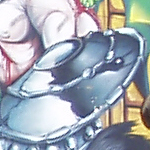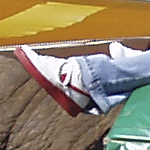Olympus Stylus Verve: Fashion vs Performance
by Stephen Caston on November 4, 2004 12:05 AM EST- Posted in
- Digital Camera
General Image Quality
For these pictures, the camera was reset to its factory default setting. Then, it was set to its highest quality recording setting. The pictures were taken in Auto mode unless stated otherwise. Portrait-style images have been rotated using Irfanview's "lossless operations". Click on a thumbnail to view the full-size image. The crops below the thumbnails are 100%.  Click to enlarge. |
 Click to enlarge. |
 Click to enlarge. |
 |
 |
 |
| In this image, the Stylus Verve displays one of its most significant quality issues: jaggies. We can see them along several edges in this shot. These jaggies are caused by a high level of in-camera sharpening. | Again, the jaggies are very visible and there is a loss of detail due to the oversharpening. On the positive side, exposure and color saturation are very good. | In this dynamically-lit image, the Stylus proves it has a decent dynamic range. It is able to retain a fair amount of detail in shadow areas while avoiding a severe overexposure of bright objects. |
Overall, we are disappointed with the image quality of the Stylus Verve. It has the potential to be very impressive. The camera produces well-balanced exposures consistently with excellent color saturation. In addition, there are no signs of chromatic aberrations. However, our biggest complaint is in reference to the in-camera oversharpening. This produces jaggies and, ironically, gives images a fuzzy appearance. It would be great if there was an option to adjust the default sharpness.
Night mode
 Night Scene mode (4 sec., f/4.0, ISO 100) Click to enlarge. |
 |
In this 4-second exposure taken in Night Scene mode, there is a fair amount of noise that is especially noticeable in the dark sky. When we set the camera manually to ISO 64 in an attempt to produce an image with less noise, the maximum 4-second exposure was not long enough to produce a bright image. It is really too bad that the Stylus Verve limits exposures to 4 seconds. Otherwise, the camera would be capable of taking some decent night pictures.
Movie mode

(320x240, 15 fps)
Click to view.
Movie mode on the Stylus Verve does not stand out as being particularly impressive. At 15 fps and a maximum resolution of 320x240, it pales in comparison to other digicams offering 30 fps and 800x600 options. However, there are some good things to say about it. The Verve does not limit recording time. It is able to record until the remaining flash card capacity is depleted. Additionally, the Verve offers white balance, exposure compensation, ISO, metering, and macro capabilities in movie mode.










10 Comments
View All Comments
shuttleboi - Thursday, November 4, 2004 - link
When is Anandtech going to review portable storage devices/personal video players?Souka - Thursday, November 4, 2004 - link
grab a Canon S410 for $275 delievered from a variety of online places...jiulemoigt - Thursday, November 4, 2004 - link
you'd think after getting acess to fuji's electronics they'd have really nice optic combined with their really nice lenses... only these look cool but have crappy eletronics and crappy lenses!Foxbat121 - Thursday, November 4, 2004 - link
I bought one for my wife for just $299 (Newegg). It's a nice camera for what it is intended for (point and shoot in a compact design). Overall, it is well worth the money I paid for considering the similar sized cameras are no cheaper either with lower resolution (Canon SD110, 3MP).AtaStrumf - Thursday, November 4, 2004 - link
Looks like a nice little camera. Its a shame its so expensive.stephencaston - Thursday, November 4, 2004 - link
WooDaddy, thanks for the comment. I agree, it is shocking to see such jagged edges in the pictures taken by this camera. As for the details of Olympus's image processing, I'm sorry I can't offer any specifics. Since this is a point and shoot camera, we can only assume that Olympus designed the process this way so that users would not need or want to post-process the images at all. Indeed, if these images are printed at the popular 6x4" format, the problem would be hard to see. And it looks like Olympus knows this.WooDaddy - Thursday, November 4, 2004 - link
Stephen can you comment on this for me?As a previous owner of an olympus camera (back in 1999) it just seems that Olympus doesn't get it when it comes to handle aliasing? Looking at the resolving fine lines page, it looks like their aliasing algorithm or low-pass filter is non-existant. Do you see it too? Suggestions?
WooDaddy - Thursday, November 4, 2004 - link
Good article.I'm glad a review finally came out for this camera... But I'm disappointed that Olympus feels it's worth $399. There are a PLETHORA of other cameras that perform so much better than this one. I agree that the price is too much. Don't be afraid to say that. Hell, I think it's just plain ridiculous. I'm starting to think the limits have been met for the megapixel squeeze; meaning a 4mp sensor in a camera with a tiny/crappy lens just is a waste of money. Especially when the aperture isn't fast nor slow.
Maybe a Foveon sensor in the same package... but nope.
I disagree with #1 though. Viewfinder in compact cameras have always been limiting and inaccurate. I understand the feeling of pressing up a camera against your face just makes you feel good and professional like, but in the digital world where you can take better pictures now, LCD-only is the way to go. Heck I wish I had a big 2.5" screen on mine.
goku21 - Thursday, November 4, 2004 - link
That is one hairy arm =)CasmirRadon - Thursday, November 4, 2004 - link
Very very pretty.You know though, all other negatives aside (did anyone expect it to perform above average?) I got to say that I really don't like the idea of not having a quality viewfinder on these ultracompact cameras. I just plain don't like taking pictures with the LCD screen.